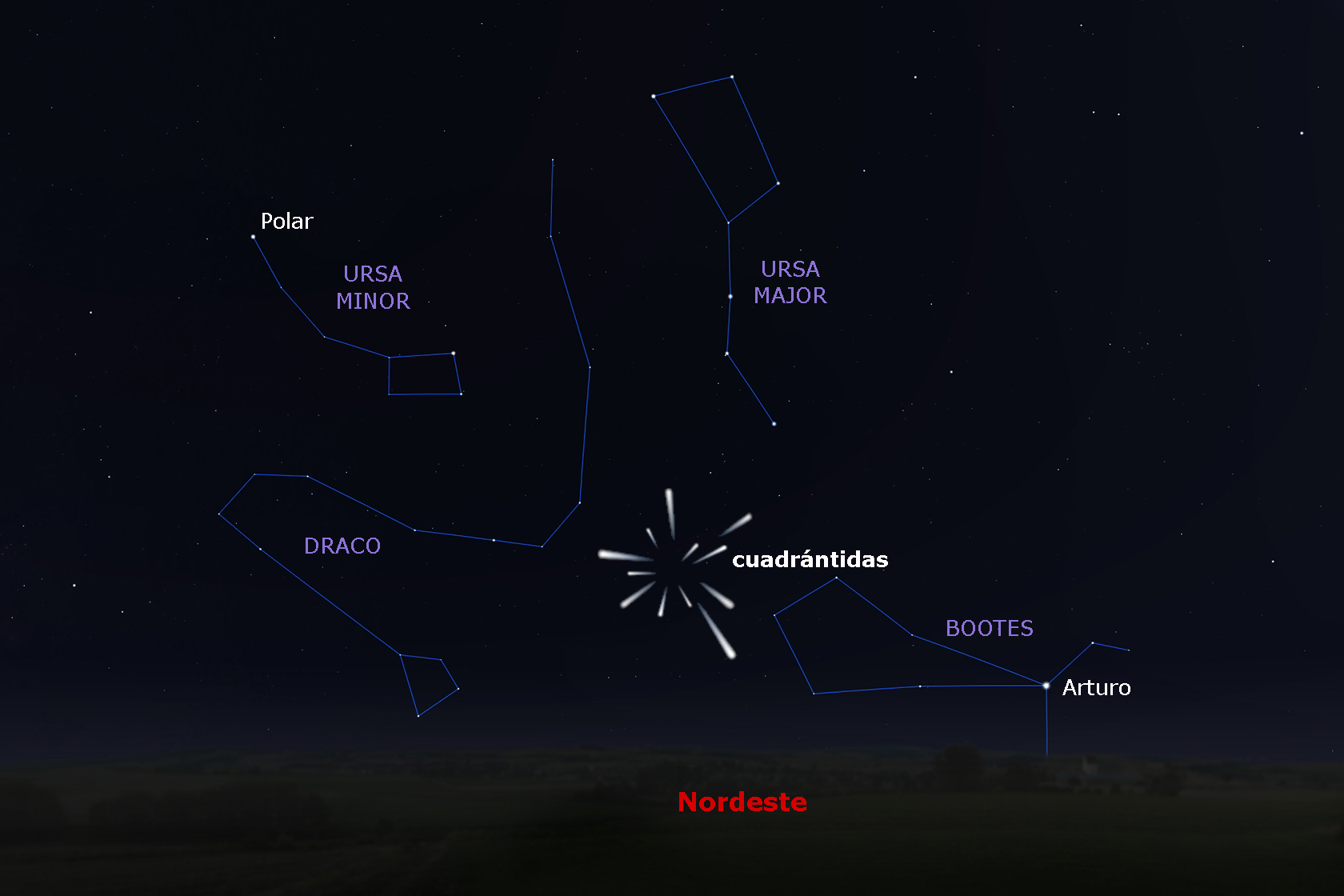Cuadrántidas
La lluvia de las cuadrántidas es la primera lluvia de meteoros del año en el hemisferio norte. Es visible entre el 28 de diciembre y el 12 de enero, y su momento de máxima actividad sucede hacia el 3 de enero.
Las cuadrántidas pueden tener una tasa de actividad por encima de los 120 meteoros por hora y una velocidad de 41 kilómetros por segundo, lo que las convierte en una de las lluvias más activas del año junto a las perseidas de agosto y las gemínidas de diciembre. Sin embargo, los meteoros de las cuadrántidas no se ven tan a menudo como los meteoros de las otras dos lluvias, debido a que su periodo de máxima actividad suele durar tan solo unas pocas horas y a las malas condiciones meteorológicas habituales en el invierno boreal.
Para observadores a nuestras latitudes, 40º norte, el radiante de las cuadrántidas se sitúa por encima del horizonte desde el anochecer hasta el amanecer.
¿Qué se espera en 2025?
En 2025 la observación de esta lluvia de estrellas, una de las más fuertes del año, se verá lastrada en 2025 por el momento del máximo, que tendrá lugar a las 16 horas de tiempo oficial peninsular del día 3 de enero. Dada la fecha, las condiciones meteorológicas también pueden ser adversas).
En la noche previa y la posterior, la Luna, con una iluminación en torno al 10%, no causará muchas molestias para la visibilidad de meteoros débiles.
¿Por qué suceden?
El origen de las cuadrántidas sigue siendo incierto. Algunos astrónomos especulan con la idea de que el asteroide 2003 EH1 puede ser el que causa la lluvia de estrellas. Este asteroide fue descubierto en el año 2003, y se cree que está relacionado con el cometa extinto C\1490 Y1 observado por astrónomos chinos, japoneses y coreanos hace unos 500 años.
Como todos los años por estas fechas, la Tierra atraviesa un anillo poblado con los fragmentos desprendidos supuestamente del asteroide 2003 EH1. Cuando uno de esos fragmentos (o meteoroides) entra en contacto con la atmósfera terrestre, se calcina por la fricción con el aire creando así el resplandor luminoso que conocemos como meteoro o estrella fugaz. Típicamente, los meteoros más comunes que observamos a simple vista los producen partículas de unos milímetros a unos centímetros de tamaño que se queman a unos 100 kilómetros de altura.
La correspondiente lluvia de meteoros parece tener un único centro de origen, un punto del que parecen surgir todas las estrellas fugaces. Ese punto se denomina "radiante" y su localización se suele utilizar para nombrar a la lluvia de estrellas. El lugar de donde parecen salir las cuadrántidas se encuentra al norte de la constelación de Bootes (el Boyero), cerca de la cola de la Osa Mayor. El nombre de las cuadrántidas proviene de la constelación Quadrans Muralis, designada así por el astrónomo francés Jerome Lalande en 1795, pero actualmente no reconocida por la Unión Astronómica Internacional (IAU).

El 'radiante' de las cuadrántidas.
¿Qué hacer para ver las cuadrántidas?
El lugar de observación puede ser cualquiera con tal de que proporcione un cielo oscuro. Es preferible observar desde un lugar que tenga pocos obstáculos para la vista (como edificios, árboles o montañas), y no utilizar instrumentos ópticos que nos limiten el campo de visión. Aunque las cuadrántidas parecen venir de la constelación de Bootes, se pueden ver en cualquier parte del cielo. Conviene dirigir la mirada hacia las zonas más oscuras, en la dirección opuesta a la posición de la Luna si la observación se realiza cuando esta esté presente. Lo más cómodo es tumbarse y esperar a que la vista se acostumbre a la oscuridad. Dada la época del año, es imprescindible ir bien abrigado.

